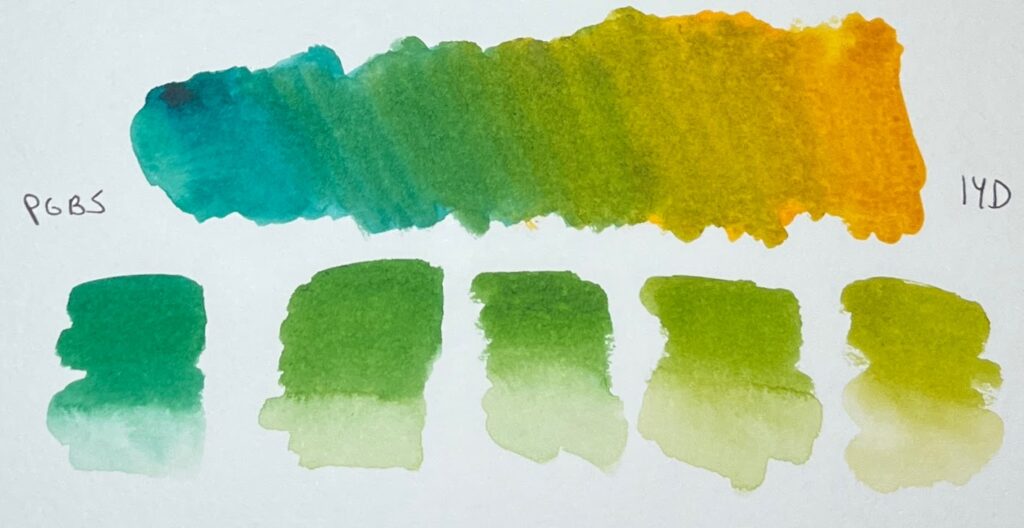
These two deep yellows are very similar in hue, so what’s the difference?
I find Hansa Yellow Deep (this Daniel Smith one, at least) to be slightly more yellow, where as the Holbein Isoindolinone Yellow Deep that I tested is slightly more orangey. If I’m squinting, HYD looks more dull in masstone but brighter in midtone. They are, however, nearly identical.
They also have very similar properties. Both are bold and smooth (non-granulating) colors. Both are semi-transparent, with IYD being a bit more transparent.
Pigment Properties
Both are synthetic pigments. PY65, usually called Hansa Yellow Deep, is a mono azo arylide yellow. PY110 is an isoindolinone yellow.
Lightfastness
Both pigments are lightfast, earning an excellent (I) rating from the ASTM per ArtIsCreation. PY65 had 7-8 ratings on the Blue Wool Scale, while PY110 had 8 ratings (top score). That said, Bruce MacEvoy’s 2004 tests give Winsor Yellow Deep (PY65) top marks, with Daniel Smith and others slightly lagging behind. For PY110, Daniel Smith’s Permanent Yellow Deep gets top marks. DV and Holbein were not tested. Either way, the differences seem minimal.
Toxicity
Both pigments are nontoxic, getting an A rating from ArtIsCreation.
Cost
PY65 is a cheaper pigment to produce. In Daniel Smith, the only line I could find which offered both pigments as single-pigment paints, Hansa Yellow Deep (PY65) is series 1, the cheapest cost series, while Permanent Yellow Deep (PY110) is series 2.
Color Mixes
Quin Coral


Extremely similar. In mixes, this particular Iso Yellow Deep seems a bit more streaky compared to this particular Hansa Deep, but I’m not sure if this is a general characteristic of all versions.
Quin Rose (PV19)


These both make bright, clean grapefruit corals.
Ultramarine Blue (PB29)


I found it easier to get dark blues with HYD. Both make grayish non-greens.
Phthalo Blue (PB15:3)


Both of these have the capacity of make rather muted greens. Again, darks were easier with HYD.
Phthalo Green (PG7)


Both of these make a range of bold, bright summer foliage greens. The combination of PG7 and PY110 is used by some companies for a premixed Hooker’s Green (e.g. M Graham’s).
Real-Life Situations
I tested both paints, as well as the more orangey Benzimida Orange (PO62), in a series of thumbnails that mimic situations in which I’d use a yellow-orange: a tropical sunset with Quin Rose; a cityscape dusk with Ultramarine; and a foliage color when mixed with Phthalo Green. (Note: this page uses the DV version of Hansa Yellow Deep, whereas the mixes above used the DS version.)

Again PY65 and PY110 fared very similarly. PO62, to my eye, did not look as good in skies and makes significantly duller green mixes – it was hard to keep it from going gray.
What Others Say
One rarely sees PY65 used in artists’ palettes: the hue is a little too orange to be preferred over a middle yellow, and although it is slightly less opaque than cadmium yellow deep, it is not as strong in mixtures. Isoindoline yellow (PY110) has a nearly identical hue and may be a superior pigment for lightfastness, transparency, and lyrical color shifts.
Bruce MacEvoy, handprint.com
Palette Appearance

PY65 appears similar to its masstone appearance, like many semi-opaque pigments. My Holbein PY110 has a duller palette appearance, looking like a dull orange/ochre color until it is painted out much lighter.
Conclusion
I found these colors very similar in mixes. Both are quite bright, though they each shine in different situations; PY110 is more transparent and looks more luminous at the dilute end, while PY65 is more opaque and looks bolder in masstone (and dry on the palette).
The Holbein PY110 I was using was a bit streaky and harder to grade easily than the PY65s I tried (I have since tried PY65 in DS, WN, and DV and found them all very smooth; I’ve slightly tried Daniel Smith’s PY110 and also found it fairly streaker and more orangey). PY110 appeared to have more range unmixed, yet PY65 was easier to use in dark mixes.
Winner: Personally, I preferred PY65, for brightness and ease of handling/mixing. It’s also cheaper and easier to find in more lines.
As an additional data point, I own two PY110s (Roman Szmal and Rosa Gallery) that are more orange than yours, almost in PO62 territory. So I don’t use them for greens much. (I also have Schmincke, which seems quite similar to the Da Vinci PY65.)
So maybe PY65 is a safer bet as a pigment, when looking for a green-mixing warm yellow?